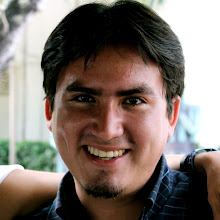
Moleskine Literario, blog by Ivan Thays
The first approach to the Web 2.0 in Peru was through the use of blogs. Many people posted poems and stories, but also critic articles and literary agendas. The boom of the blogs was between 2004 and 2007. Some Peruvian well-known writers and academics like Gustavo Faverón, Ivan Thays, Rocío Silva Santisteban, Santiago Roncagliolo and recently Julio Ortega started to publish binnacles on the web. Faveron and Ortego don´t live in Peru, but their blogs allow them to have presence in the local discussion. Some of them, like Thays, realized that the next step to don´t lose the virtual interaction was join in the world of the social networks. His blog, Moleskine Literario now has a page in Facebook and Twitter.

Blog by Julio Ortega
Is a social network the same as a blog? Ricahrd Grassman and Peter Case explain that a social network is “a relational complex ma de up by subject positions that are mediated by an online platform whose purpose is to facilitate inter-subjective interaction” (177). A Blog, is mainly a virtual binnacle with comments. There is interaction, but there is not still the idea of ‘being part’ of a community. Some cultural blogs like ‘Gran Combo Cub’ and ‘La gran Combi were created as groups of people with the interest of making a ‘blog colectivo’, but those were not exactly ‘virtual communities’.
Social networks are also in Xbox and computer games like Second Life[i] were is applied the precept of making random people (who, at the beginning don’t have nothing in common) a part of a community. People from different cities, ages and lifestyles participate and become a part of a new heterogeneous virtual-body.
Before the appearance of Facebook, blogs were aiming to create this virtual community. Many independent journals use them to expose corruptions government scandals because they were banned by traditional media (Tv, radio). Peruvian Blogs used a platform to be connected: Perublogs, a website that tried to be like a social network of bloggers. Perublogs offered a ranking of Peruvian blogs. Many unkown people became famous in the literary field thanks to their blogs and the already know people found there an opportunity to show a new facet of them. For example, Ivan Thays, but also the scholar and professor Camilo Fernández Cozman (his blog became one of the most visited in Peru).
But, what happened with the blogs? They are still useful. However, why they started to lose popularity? The interface of Facebook was presented as more interactive but also more safety. In the blogosphere trolls, spam and anonymous comments were growing every day. However many academic debates are registered in blog like ‘El hablador’ (by former literature students) and ‘Puente Aéreo (by G. Faverón), both managed by literary critics. The innovation was based on switching from the traditional space and try to create a more democratic forum.
Facebook is more interactive and with more functions allowed to post more things. Since simple things (“I´m tired), posting events (my birthday party, a conference, a music festival) and being part of a debate in a more secure environment.
Suddenly, instead of receiving invitations to book presentations by e-mail, it was more easier to create and event on Facebook and share the invitation with contacts. Thus, many business started to create profiles in this social networks.
However still blogs keep one of the most important chapter of the history of Peruvian Literature in the Web 2.0 age and the protagonist was not precisely a person who was in the ‘literary circle’. A young journalist, Renato Cisneros started in 2007 (until February 2010) a blog called ‘Busco Novia’[ii] that became on the most visited in country, for office workers. The blog had a simple but popular thematic: stories of he conquered many woman, a kind of a Peruvian-urban and contemporary Don Juan. If was not the first Peruvian blog, was the first to show the effect of the Web 2.0 in literature. In 2008, Santillana Press made a book of the blog: Busco Novia: el libro del blog, and according to the author[iii], the original idea was just only to publish a selection of the posts from the blog, but then Santillana decided to include reader comments that were selected by readers. The final product was a Book 2.0.
In the early 2000, Terra.com also published every week one chapter of Jaime Bayly´s book Los amigos que perdí , but with a static format. Is with Cisneros, when the 2.0 show their influence in the ‘Peruvian-real world’. It is important to point out that Real and virtual world are not separated dimensions. They are linked and one influence the other.
What was not accepted because it was too ‘massive’ suddenly was impossible to avoid. Many people joined the 2.0 world, but not all followed the basic rule: interaction.
Most interactive blogs became the most popular ones. Many blog author though that posting articles was enough, but they didn´t realize of responding to the comments left by their readers. The ones who did it finally succeed and received more visitors.
[iii]Interview made by Marco Sifuentes for the blog Utero.pe http://www.youtube.com/watch?v=173ZaOFLVpw


No comments:
Post a Comment